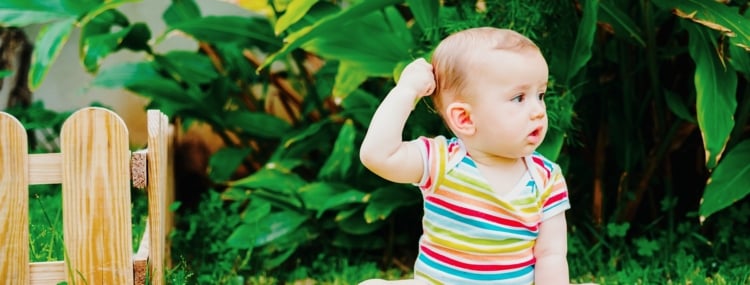Have you ever claimed you were so stressed that you could pull your hair out? As it turns out, babies feel that too! Hair pulling is a common self-soothing technique for many babies. In some cases, hair pulling or hair twirling is harmless. If the habit continues, however, it could lead to a more serious condition as your baby grows up.
-
Tracking cycle
-
Getting pregnant
-
Pregnancy
-
Help Center
-
Flo for Partners
-
Anonymous Mode
-
Flo app reviews
-
Flo Premium New
-
Secret Chats New
-
Symptom Checker New
-
Your cycle
-
Health 360°
-
Getting pregnant
-
Pregnancy
-
Being a mom
-
LGBTQ+
-
Quizzes
-
Ovulation calculator
-
hCG calculator
-
Pregnancy test calculator
-
Menstrual cycle calculator
-
Period calculator
-
Implantation calculator
-
Pregnancy weeks to months calculator
-
Pregnancy due date calculator
-
IVF and FET due date calculator
-
Due date calculator by ultrasound
-
Medical Affairs
-
Science & Research
-
Pass It On Project New
-
Privacy Portal
-
Press Center
-
Flo Accuracy
-
Careers
-
Contact Us
How to Manage Hair Pulling in Babies: Unheard-Of Tips That Work


Every piece of content at Flo Health adheres to the highest editorial standards for language, style, and medical accuracy. To learn what we do to deliver the best health and lifestyle insights to you, check out our content review principles.
Read on for some tried and tested tips you can use to stop your baby from pulling their hair.
Why a baby is pulling their hair?
As a mom, you've probably learned lots of different ways to calm your baby if they're tired, cranky, or hungry. From soothers to nursing, lullabies to rocking chairs, you do everything you can to make your baby feel better.
As babies get older, they learn self-soothing techniques to help calm themselves down or make themselves feel safe. Though it might not look very comforting, hair pulling is a common way that babies comfort themselves. Hair twirling and hair pulling develops as a habit from around six months old and can continue well into the first year. The habit tends to be more common in girls than boys, but it can affect both sexes.
Take a quiz
Find out what you can do with our Health Assistant
If you notice that your baby starts to tug at their hair, it could be a sign that they're feeling overwhelmed. The habit can be a demonstration that your baby is self-soothing during moments of stress or anxiety. Adults do it, too. This habit is seen in 1–4% of the population, and it's more common in women than in men. It usually starts during childhood or adolescence, and is associated with a stressful event in 25% of patients.
There are several different reasons why your baby might be twirling or pulling their hair. Here are some common situations where your baby might use hair pulling as a coping mechanism:
They're tired
If your baby is tired, they might twirl their hair as a way of winding down. Your baby might also pair hair twirling with sucking their thumb as a way of soothing themselves to sleep.
They're cranky
You might also see your baby reach for their hair and start to pull or twirl it if they are getting fussy. Because hair twirling is a favorite way for a young child to calm themselves down, it could be a good body language cue for you to recognize situations where your baby might be needing some comfort.
They're nursing
Some babies will gently tug at the hair on the back or sides of their heads while they're breastfeeding as a way of comforting themselves. If your baby is teething, they might also pair hair twirling with biting to help relieve pain in their gums.
They're teething
If your baby is pulling at the hair behind or around their ears, it could be a sign that they're teething. Hair and ear pulling could indicate that your baby is experiencing some pain in their gums or jaw, and they're trying to alleviate that pain.
They're having fun
If your baby only occasionally tugs their hair, it could simply mean that they're playing! Perhaps your baby has just discovered that they have hair, and they're twirling it around their fingertips to familiarize themselves with the new texture and sensation.
How to manage hair pulling in babies?
Generally speaking, occasional and light hair twirling by your baby isn't something to be too concerned about. If your baby becomes so attached to twirling their hair that it prevents them from holding onto other things, or they start to actually pull their hair out of the scalp and develop bald spots, then it's time to intervene.
When you notice your baby pulling their hair, you can try:
- Offering something else for them to hold on to, like a soothing blanket or favorite toy
- Giving them a stuffed animal with long hair or fur to tug and twirl
- Playing a hand-eye coordination game like patty cake or the itsy-bitsy spider
- Comforting your baby with a gentle cuddle
- Gently massaging the spot on their head where they want to pull from and nudging their hands and arms down to rest
If you notice your baby is pulling their hair, stay calm when you correct the behavior. Remember that some light hair pulling is normal in young kids and not something to worry about. But if your baby starts to develop bald spots, or the habit becomes more frequent, continue to try and distract or redirect your baby's attention to something else whenever you notice them going for their hair.
Just because you might be suffering from post-partum hair loss, doesn't mean your child should be going bald from hair pulling. As with other habits like biting nails or sucking thumbs, most people recommend trying to intervene hair pulling before your child develops it into a bad habit. A frequent hair pulling habit can develop into a more serious condition called trichotillomania if it continues into your child's school-aged years.
If a baby is pulling your hair

What if your baby is pulling your hair? In this case, it's a habit that's best nipped in the bud. The first time your baby pulled your hair they likely got a reaction out of you: maybe you let out a little yell or started to laugh. Your baby recognizes this response and will try it again and again, hoping to get your attention.
To stop your baby from pulling your hair try:
- Tying your hair back when your nursing or carrying your baby, so they can't reach anything to pull on. Stretch marks and sore nipples are enough with breastfeeding, you don't need the extra pain from having your hair pulled!
- Calmly and firmly saying no as you release their grip and move your hair out of the way. Offer a gentle alternative, like showing them how to softly stroke your hair instead.
- Distracting them with something else, like playing with a toy or singing a song.
Whatever tactic you use to stop your baby from pulling your hair, be consistent. The more they learn that it's not something they should be doing, the quicker they'll give up trying to pull your hair.
Hair twirling in babies is a common self-soothing technique. The habit only becomes harmful if they start to pull their hair out completely or they develop bald spots. As with any bad habits, the sooner you can intervene the better.


Hey, I'm Anique
I started using Flo app to track my period and ovulation because we wanted to have a baby.


The Flo app helped me learn about my body and spot ovulation signs during our conception journey.


I vividly
remember the day
that we switched
Flo into
Pregnancy Mode — it was
such a special
moment.
Real stories, real results
Learn how the Flo app became an amazing cheerleader for us on our conception journey.
References
https://raisingchildren.net.au/guides/a-z-health-reference/ear-tugging
https://www.schn.health.nsw.gov.au/fact-sheets/trichotillomania
https://www.parents.com/advice/babies/baby-development/why-is-my-baby-pulling-his-hair/
https://parenting.firstcry.com/articles/hair-pulling-in-babies-what-you-can-do/
https://raisingchildren.net.au/babies/behaviour/common-concerns/biting-pinching-hair-pulling




